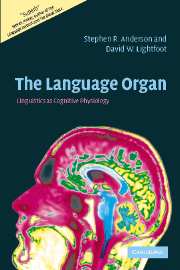Book contents
- Frontmatter
- Contents
- Preface
- 1 Studying the human language faculty
- 2 Language as a mental organ
- 3 Syntax
- 4 Sound patterns in language
- 5 Describing linguistic knowledge
- 6 Phonetics and the I-linguistics of speech
- 7 Morphology
- 8 Language change
- 9 “Growing” a language
- 10 The organic basis of language
- References
- Index
4 - Sound patterns in language
Published online by Cambridge University Press: 03 December 2009
- Frontmatter
- Contents
- Preface
- 1 Studying the human language faculty
- 2 Language as a mental organ
- 3 Syntax
- 4 Sound patterns in language
- 5 Describing linguistic knowledge
- 6 Phonetics and the I-linguistics of speech
- 7 Morphology
- 8 Language change
- 9 “Growing” a language
- 10 The organic basis of language
- References
- Index
Summary
In this chapter and the two following ones, we turn from issues of syntactic organization in natural language to the systematicities of sound structure. There is a conventional division between phonetics, or the study of sounds in speech, and phonology, the study of sound patterns within particular languages. As we will see, there is a reasonably clear conceptual distinction here, and we will follow it in devoting most of this chapter and the next to the more obviously linguistic domain of phonology while postponing substantive discussion of the nature of phonetics until chapter 6, after some necessary preliminaries in section 4.1. We will attempt to tease apart these notions, but that process will reveal that questions of sound structure, seemingly concrete and physical in their nature, are actually abstract matters of cognitive organization – aspects of I-language and not measurable external events.
Ideally, we should broaden our scope a bit: signed languages also have a “phonology” (and a “phonetics”) despite the fact that this is not based on sound, although we cannot go into the implications of that within the scope of this book.In recent years, the study of signed languages has revealed the fact that their systems of expression are governed by principles essentially homologous with those relevant to spoken language phonology and phonetics. This close parallelism reinforces the conclusion that we are dealing here with the structure of the mind, and not simply sound, the vocal tract, and the ears (or the hands and the eyes).
- Type
- Chapter
- Information
- The Language OrganLinguistics as Cognitive Physiology, pp. 67 - 91Publisher: Cambridge University PressPrint publication year: 2002



